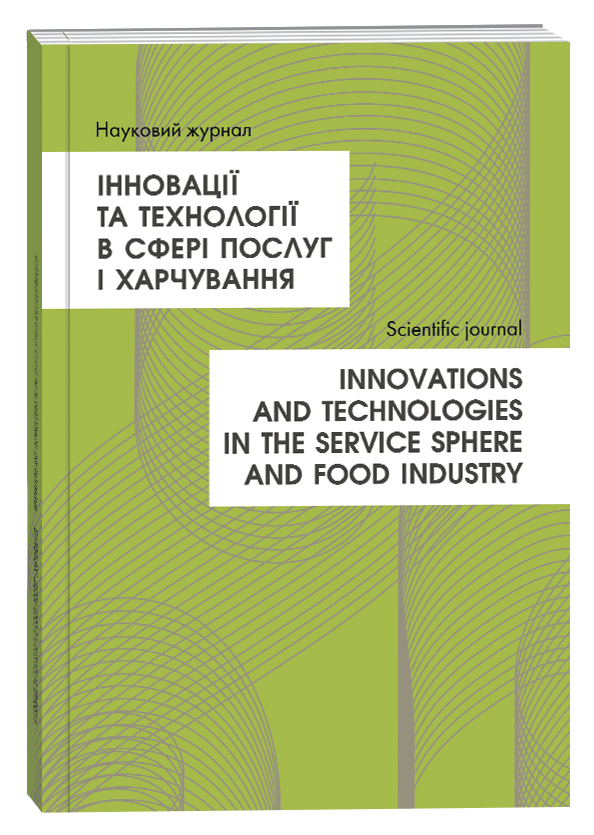CHEMORECEPTION IN THE WORLD OF BEER
Abstract
Actuality of the given problem solution is to analyze beer chemoreception. Chemoreception is a sensory mechanism of taste and smell perception, able to function as a single unit of the detection and selection of food and beverages. The article presents the results of an empirical analysis of chemoreception of food beverages, which showed that taste and smell are interrelated and dependent on each other. Taste and smell perform different, though interrelated, functions. The olfactory sensations nevertheless belong to the category of distant objects and reflect the individual properties of physical objects located at a distance from a person. Taste sensations, on the contrary, are contact: they occur when the taste medium (e.g. food) is already in the mouth. The study empirically confirms and theoretically proves that the information given in the article aims to briefly and visually introduce the rich world of beer and provide the necessary knowledge to understand it and, most importantly, to enjoy it. Sensory testing is part of the overall system of control operations conducted at the food enterprise. Sensory testing, as part of quality control, has for many years been regarded as an element of qualitative rather than quantitative research. The introduction of analytical methods of sensory evaluation, the use of modern systematic methods and information technologies will allow to move the organoleptic evaluation from the qualitative plane to quantitative one, which, in turn, made it possible to implement sensory quality control. Sensory evaluation can be the basis of food quality control and customer demand forecasting. Scientific methods of sensory analysis are widely used in the West in the production and circulation of food products. The results of the study can be useful for small breweries owners, scientists, teachers, students of higher education who master the specialty "Food Technology" and others.
References
Алексеева, Н. (2006). Все о пиве. М.: АСТ; Донецк: Сталкер, 157.
Бойко, М. І., Березка Т.О., Мольченко С. М. (2017) Розробка технології пива з новими органолептичними властивостями. Вісник Національного технічного університету «ХПІ». Харків: НТУ «ХПІ», № 41 (1263). С. 76–80.
Мошер, Ренді (2018). Смак пива. Інсайдерський путівник у світі найвидатнішого напою людства. Львів: Видавництво Старого Лева, 388 с.
Нагурна, Н. А. & Осипенкова І. І.& Чепурна О. Л. (2017). Основи сенсорного аналізу: [навч.посіб.]. Черкаси, 219 с.
Петроченков, А. В. (2016). Крафтовое пиво. Пивная революция: руководство от инсайдера. ЭКСМО, 208 с.
Стэндидж, Т. (2008). История мира в шести стаканах. Екатеринбург: «У – Фактория», 320 с.
Ткаченко, Т. І. Розробка моделі сенсорного контролю якості на харчових підприємствах. Взято з file:///C:/Users/User/Downloads/4591-7000-1-SM%20(1).pdf.
Cornell, Martyn (2004). Beer: The Story of the Pint. London: Headline, 328.
Hennessy, gonathan, and Mike Smith, Art from Aaron McConnell. The Comic Book Story of Beer (2015). Berkeley: Ten Speed Press.
Hornsey, Jan (2004). A History of Beer and Brewing. London: The Royal Society of Chemistry.
Pattinson, Ron (2014). The Home Brewer's Guide to Vintage Beer: Rediscovered Recipes for Classic Brews Dating from 1800 to 1965. Quarry Books.
Portal, T. S. (липень 2017 p.). Beer production worldwide from 1998 to 2016. Взято з Statista: statista.com
Alekseeva, N. (2006). Vse o py`ve [Everything about Beer]. M.: AST; Doneczk: Stalker, 157.
Boyko, M. I., Berezka T.O., Mol'chenko S.M. (2017) Rozrobka tekhnolohiyi pyva z novymy orhanoleptychnymy vlastyvostyamy [Development of beer technology with new organoleptic properties]. Visnyk Natsional'noho tekhnichnoho universytetu «KhPI». Kharkiv: NTU «KhPI», # 41 (1263). S. 76–80.
Mosher, Randi. (2018). Smak py`va. Insajders`ky`j putivny`k u sviti najvy`datnishogo napoyu lyudstva [Tasting Beer. Insider’s Guide to the World’s Greatest Drink]. L`viv: Vy`davny`cztvo Starogo Leva, 388.
Nagurna, N. A. & Osy`penkova I. I.& Chepurna O. L. (2017). Osnovy` sensornogo analizu [The Basics of Sensory Analysis]: [navch.posib.]. Cherkasy`, ChDTU, 219.
Petrochenkov, A. V. (2016). Kraftovoe pivo. Pivnaya revolyutsiya: rukovodstvo ot insaidera [Craft beer. Beer revolution: Insider guide]. EKSMO, 208 s.
Standydzh, T. (2008). Y`story`ya my`ra v shesty` stakanax [World’s History in Six Glasses]. Ekatery`nburg: «U – Faktory`ya», 320s.
Tkachenko, T. I. Rozrobka modeli sensornogo kontrolyu yakosti na xarchovy`x pidpry`yemstvax [Development of the Model of Quality Sensory Control on Food Enterprises].
Cornell, Martyn. (2004). Beer: The Story of the Pint. London: Headline, 328.
Hennessy, gonathan, and Mike Smith, Art from Aaron McConnell. The Comic Book Story of Beer (2015). Berkeley: Ten Speed Press.
Hornsey, Jan (2004). A History of Beer and Brewing. London: The Royal Society of Chemistry.
Pattinson, Ron (2014). The Home Brewer's Guide to Vintage Beer: Rediscovered Recipes for Classic Brews Dating from. 1800 to 1965. Quarry Books
Portal, T. S. (липень 2017 p.). Beer production worldwide from 1998 to 2016. Retrieved from з Statista: statista.com



